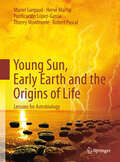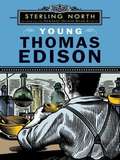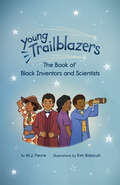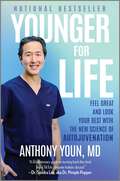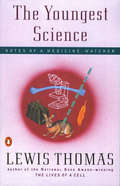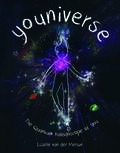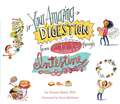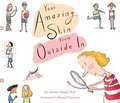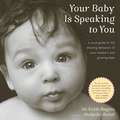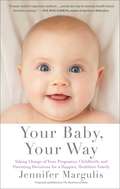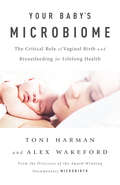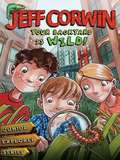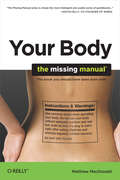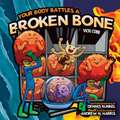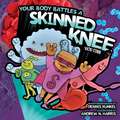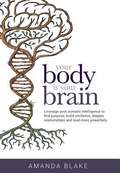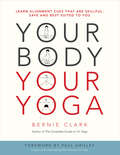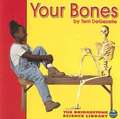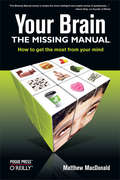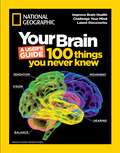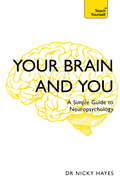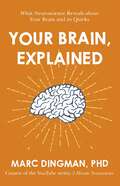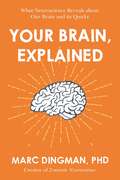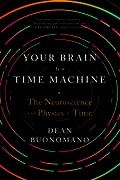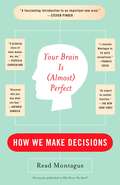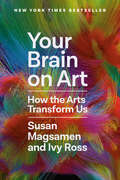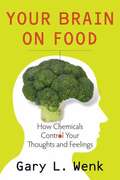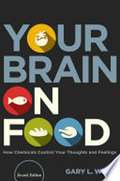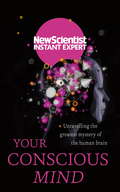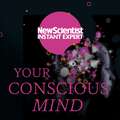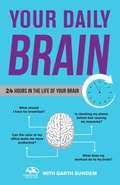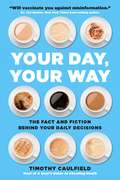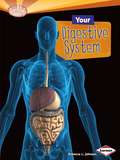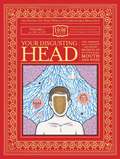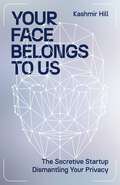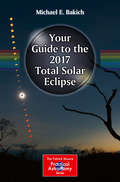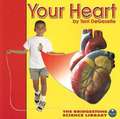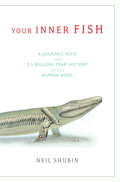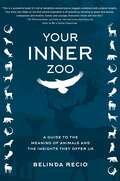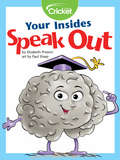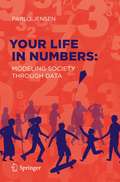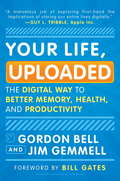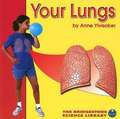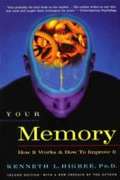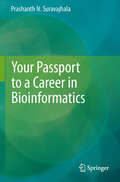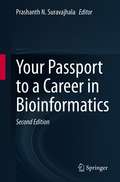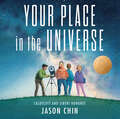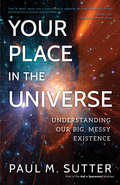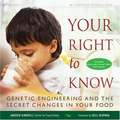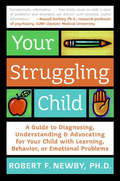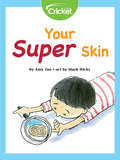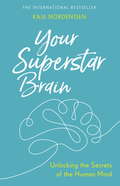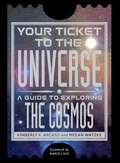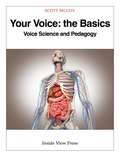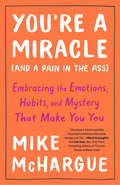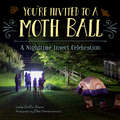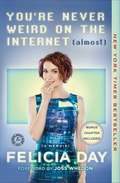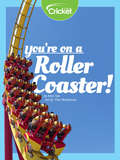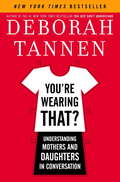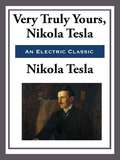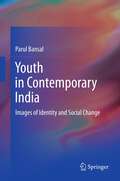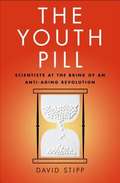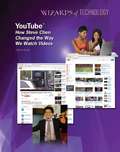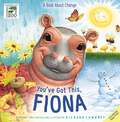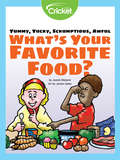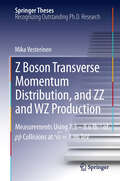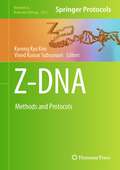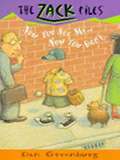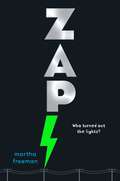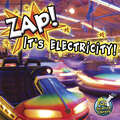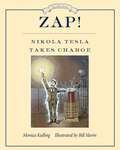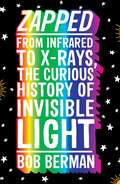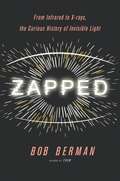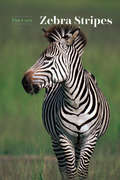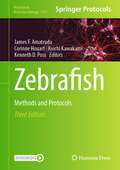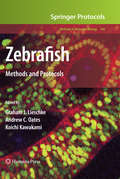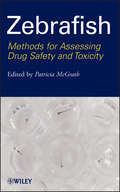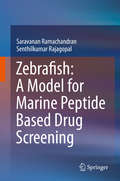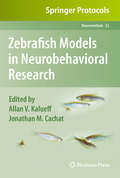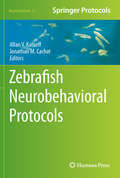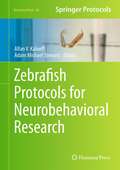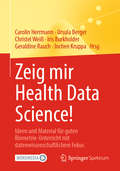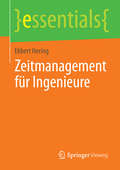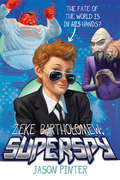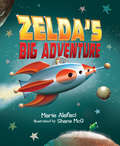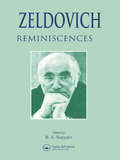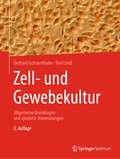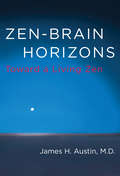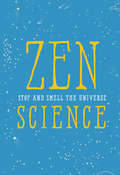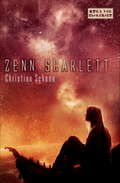- Table View
- List View
Young Sun, Early Earth and the Origins of Life
by Hervé Martin Muriel Gargaud Purificación López-García Robert Pascal Storm Dunlop Thierry Montmerle- How did the Sun come into existence? - How was the Earth formed? - How long has Earth been the way it is now, with its combination of oceans and continents? - How do you define "life"? - How did the first life forms emerge? - What conditions made it possible for living things to evolve? All these questions are answered in this colourful textbook addressing undergraduate students in "Origins of Life" courses and the scientifically interested public. The authors take the reader on an amazing voyage through time, beginning five thousand million years ago in a cloud of interstellar dust and ending five hundred million years ago, when the living world that we see today was finally formed. A chapter on exoplanets provides an overview of the search for planets outside the solar system, especially for habitable ones. The appendix closes the book with a glossary, a bibliography of further readings and a summary of the Origins of the Earth and life in fourteen boxes.
Young Thomas Edison
by Sterling NorthUnable to hear, Thomas Edison seemed unlikely to become one of America?s greatest inventors, but as a hardworking young man, he wasn?t about to let a minor obstacle stop him. He invented the phonograph, the incandescent lightbulb, and motion pictures, to name but three of his many important inventions. Eventually he was named ?the greatest living American. ? Follow Thomas Edison?s life from losing his sense of hearing to losing his hard-earned fortune, in this intriguing biography by Newbery Honor author Sterling North. .
Young Trailblazers: The Book of Black Inventors and Scientists
by M. J. FievreDiscover Incredible Inventions by Black People (Ages 8-12) #1 New Release in Children's Inventors Books Young Trailblazers: The Book of Black Inventors and Scientists is a fun new book for children that teaches kids about inventions by Black people that have impacted the world through their ingenuity and trailblazing innovation. From Black Inventors to Black Scientists. Take your child on an adventure and travel through time to meet famous black inventors who changed the game. Countdown to liftoff with Katherine Johnson, who helped pioneer U.S. crewed space missions. Safely cross the street with Garrett Morgan, who invented the traffic signal—or even sing your heart out with James West&’s invention of the microphone. All of these inventions by Black people have, in one way or another, shaped the past and present through trailblazing creativity and resilience; these stories are sure to inspire every child. Experience an array of rich Black history. In this book, there are Black scientists and Black inventors we all know, such as Lewis Howard Latimer and Sarah Boone. There are also dozens of Black trailblazers that we don&’t, all of whom have accomplished remarkable things in literature, entertainment, education, STEM, business, military and government services, politics and law, activism, sports, spirituality, and more. Inside this book of inventions by Black people, you&’ll find: A fun and engaging introduction to Black inventors for kids Essential Black history for kids to learn about Interesting fun facts and beautiful illustrations If you enjoyed Black Women in Science, Black Inventors, or Black Heroes, then you&’ll love Young Trailblazers.
Young-Type Interferences with Electrons: Basics and Theoretical Challenges in Molecular Collision Systems
by François FrémontSince the discovery that atomic-size particles can be described as waves, many interference experiments have been realized with electrons to demonstrate their wave behavior. In this book, after describing the different steps that led to the present knowledge, we focus on the strong link existing between photon and electron interferences, highlighting the similarities and the differences. For example, the atomic centers of a hydrogen molecule are used to mimic the slits in the Young's famous interference experiment with light. We show, however, that the basic time-dependent ionization theories that describe these Young-type electron interferences are not able to reproduce the experiment. This crucial point remains a real challenge for theoreticians in atomic collision physics.
Younger for Life: Feel Great and Look Your Best with the New Science of Autojuvenation
by Anthony YounA NATIONAL BESTSELLERFrom bestselling author and beloved social media star Dr. Anthony Youn comes a revolutionary step-by-step guide to reversing the effects of aging at any stage in lifeGrowing older is a blessing. But the slow decline and the loss of functionality associated with aging has led us to treat the process like a disease. These negative effects of aging, however, are not inevitable. Rather, they&’re largely the result of environmental and lifestyle factors that, when properly addressed, can be reversed through a process called Autojuvenation™.Dr. Youn, one of America&’s most trusted surgeons, offers a groundbreaking new approach to turning back the clock naturally. In this step-by-step guide, he shows us how, through simple changes in diet, activity and skin care, we can look younger than ever before. Readers will learn: How to reverse the aging process by combining intermittent fasting with autojuvenation-promoting foods How to develop a simple skin care routine to look younger for life Best practices for sleep hygiene, yoga, exercise, mindset and natural dental care Everything you ever wanted to know about Botox, fillers, microneedling, chemical peels, fat-blasting treatments and more A simple three-week program to jump-start the autojuvenation process to look and feel your bestPacked with accessible, innovative tips and techniques, this must-read guide shows us the simple changes you can make to live longer, look better, stay healthier and feel amazing—for life.
The Youngest Science: Notes of a Medicine-Watcher
by Lewis ThomasFrom the 1920s when he watched his father, a general practitioner who made housecalls and wrote his prescriptions in Latin, to his days in medical school and beyond, Lewis Thomas saw medicine evolve from an art into a sophisticated science. The Youngest Science is Dr. Thomas's account of his life in the medical profession and an inquiry into what medicine is all about--the youngest science, but one rich in possibility and promise.He chronicles his training in Boston and New York, his war career in the South Pacific, his most impassioned research projects, his work as an administrator in hospitals and medical schools, and even his experiences as a patient. Along the way, Thomas explores the complex relationships between research and practice, between words and meanings, between human error and human accomplishment, More than a magnificent autobiography, The Youngest Science is also a celebration and a warning--about the nature of medicine and about the future life of our planet.
Youniverse: The Quantum Kaleidoscope Of You
by Lizelle van der MerweThis nonfiction picture book, by a South African writer, explores how light weaves the universe together and how much we have in common with a quivering aspen leaf and the dust of a distant nebula. Youniverse aims to inspire a reverence for our fragile blue planet voyaging through space. The lyrical text and simple, childlike illustrations linger on one object at a time, building a mind-liberating journey from electrons and photos through atoms, molecules, cells, and the human body; outward to the solar system, the Milky Way, and the universe; and backward to the beginning of time in the Big Bang. Light weaves through the pages as it weaves the universe together, showing us that we have almost everything in common with a quivering aspen leaf and the dust of a distant nebula. “Your imagination is the greatest of miracles,” van der Merwe writes, “a consciousness that contemplates the atoms and the stars from which it was made.” A child sees a world in a tidepool and an enchanted forest in a copse of trees. Songbirds speak messages. Moonlight whispers through an open window. The inner and outer worlds flow together without boundaries. Does growing up have to mean leaving that magic kingdom behind? Lizelle van der Merwe believes that a child’s sense of wonder should instead be encouraged, expanded, and immortalized with the real-life magic of science. The more we know about the quantum worlds within and outside us, the more wisdom is evident in a child’s view of the world.
Your Amazing Digestion from Mouth through Intestine (Your Amazing Body Books)
by Joanne SettelDr. Joanne Settel has all the answers to our most burning questions in this wacky and informative book of poems about our digestive systems. Have you ever wondered… Why spicy foods can make you sweat? Why garlic makes your breath so stinky? Just how long your long intestine is? What a pizza slice looks like…going down? Why food tastes different when you have a cold? With fascinating details, catchy rhymes, and quirky illustrations by Steve Björkman, acclaimed author Joanne Settel answers all of these questions (and more!) in this engrossing, fun exploration of the science of our digestive systems. When she’s through, you won’t believe what your guts can do—or what you can stomach!
Your Amazing Skin from Outside In (Your Amazing Body Books)
by Bonnie Timmons Joanne SettelIt’s itchy, it’s sweaty, it’s embarrassing...but most of all, it’s fascinating! Dr. Joanne Settel has all the answers to our most burning questions in this wacky and informative book of poems about our skin.Have you ever wondered… Why you blush when you’re embarrassed? Why you’ve got freckles everywhere? Why your fingers wrinkle in the pool? Why your friends come in all different colors? Why mosquitoes think you’re delicious? Why you’ve got that giant pimple on your nose? Look no further! With supercool facts, clever rhymes, and hilarious illustrations by Bonnie Timmons, acclaimed author Joanne Settel answers all these questions (and more!) in this fascinating, fun exploration of the science of our skin from head to toe. When she’s through, you won’t believe what your skin can do!
Your Baby Is Speaking to You
by Abelardo Morell Kevin NugentFrom an international expert on infant-parent communication, Your Baby Is Speaking To You is destined to become a parenting classic. Through intimate access to babies and their families, Dr. Kevin Nugent and acclaimed photographer Abelardo Morell capture the amazingly precocious communications strategies babies demonstrate from the moment they are born. Your Baby Is Speaking to You illustrates the full range of behaviors--early smiling to startling, feeding to sleeping, listening to your voice and recognizing your face. The newest research--including information on subtle and fleeting behaviors not seen or explained in any other book--illuminates the meaning of the things babies do that concern and delight new parents: - the language of yawning - the rich range of cries, and how to understand their meanings - baby's earliest "sleep smiles" and sleep states, and what they signify Your Baby Is Speaking To You delivers the information parents crave in gentle, accessible style while giving parents the confidence they need to respond to their own baby's way of communicating during the very first astonishing days and the months beyond.
Your Baby, Your Way
by Jennifer MargulisWhy, despite our state-of-the-art medical technology, does the United States have among the highest maternal and infant mortality rates in the industrialized world? Why do pregnant women who are planning to breastfeed receive "free" samples of infant formula from American obstetricians? Why are American newborns given a vaccine at birth against hepatitis B, a sexually transmitted disease? The Business of Baby, an eye-opening work of investigative journalism, exposes how our current cultural practices during pregnancy, childbirth, and the first year of a baby's life are not based on the best evidence or the most modern science, revealing how American moms and their babies are being undermined by corporate interests. An illuminating combination of meticulous research and in-depth interviews with parents, doctors, midwives, nurses, health care administrators, and scientists, Margulis's impassioned and eloquent critique is shocking, groundbreaking, and revelatory. The Business of Baby arms parents with the information they need to make informed decisions about their own health and the health of their infants.
Your Baby, Your Way: Taking Charge of your Pregnancy, Childbirth, and Parenting Decisions for a Happier, Healthier Family
by Jennifer MargulisWhy, despite our state-of-the-art medical technology, does the United States have among the highest maternal and infant mortality rates in the industrialized world? Why do pregnant women who are planning to breastfeed receive "free" samples of infant formula from American obstetricians? Why are American newborns given a vaccine at birth against hepatitis B, a sexually transmitted disease? The Business of Baby, an eye-opening work of investigative journalism, exposes how our current cultural practices during pregnancy, childbirth, and the first year of a baby's life are not based on the best evidence or the most modern science, revealing how American moms and their babies are being undermined by corporate interests. An illuminating combination of meticulous research and in-depth interviews with parents, doctors, midwives, nurses, health care administrators, and scientists, Margulis's impassioned and eloquent critique is shocking, groundbreaking, and revelatory. The Business of Baby arms parents with the information they need to make informed decisions about their own health and the health of their infants.
Your Baby's Microbiome: The Critical Role of Vaginal Birth and Breastfeeding for Lifelong Health
by Toni Harman Alex WakefordFrom the Directors of the Award-Winning Documentary Microbirth At least two amazing events happen during childbirth. There’s the obvious main event, which is the emergence of a new human into the world. But there’s another event taking place simultaneously, a crucial event that is not visible to the naked eye, an event that could determine the lifelong health of the baby. This is the seeding of the baby’s microbiome, the community of “good” bacteria that we carry with us throughout our lives. The seeding of the microbiome, along with breastfeeding and skin-to-skin contact, kick-starts the baby’s immune system and helps protect the infant from disease across a lifetime. Researchers are discovering, however, that interventions such as the use of synthetic oxytocin, antibiotics, C-sections, and formula feeding interfere with, or bypass completely, the microbial transfer from mother to baby. These bacteria are vital for human health, and science has linked an imbalance in the human microbiome with multiple chronic diseases. Drawing on the extensive research they carried out for their documentary film Microbirth, authors Toni Harman and Alex Wakeford reveal a fascinating new view of birth and how microscopic happenings can have lifelong consequences, for ourselves, our children—and our species as a whole.
Your Backyard Is Wild
by Jeff CorwinA backyard anywhere is always fun to explore! When budding naturalists Lucy and Benjamin get a chance to visit their cousin Gabe in Brooklyn, they can't wait. They are used to seeing fascinating animals and plants in the Florida Everglades where they live, but they can't imagine what they will find in Gabe's New York City backyard. The first book in Jeff Corwin's young middle-grade fiction series shows kids that no matter where you live, you can have fun discovering the plants, animals, and natural life around you. .
Your Body: The Missing Manual
by Matthew MacdonaldWhat, exactly, do you know about your body? Do you know how your immune system works? Or what your pancreas does? Or the myriad -- and often simple -- ways you can improve the way your body functions? This full-color, visually rich guide answers these questions and more. Matthew MacDonald, noted author of Your Brain: The Missing Manual, takes you on a fascinating tour of your body from the outside in, beginning with your skin and progressing to your vital organs. You'll look at the quirks, curiosities, and shortcomings we've all learned to live with, and pick up just enough biology to understand how your body works. You'll learn: That you shed skin more frequently than snakes do Why the number of fat cells you have rarely changes, no matter how much you diet or exercise -- they simply get bigger or smaller How you can measure and control fat That your hair is made from the same stuff as horses' hooves That you use only a small amount of the oxygen you inhale Why blood pressure is a more important health measure than heart rate -- with four ways to lower dangerously high blood pressure Why our bodies crave foods that make us fat How to use heart rate to shape an optimal workout session -- one that's neither too easy nor too strenuous Why a tongue with just half a dozen taste buds can identify thousands of flavors Why bacteria in your gut outnumbers cells in your body -- and what function they serve Why we age, and why we can't turn back the clock What happens to your body in the minutes after you die Rather than dumbed-down self-help or dense medical text, Your Body: The Missing Manual is entertaining and packed with information you can use. It's a book that may well change your life.Reader comments for Your Brain: The Missing Manual, also by author Matthew MacDonald: "Popular books on the brain are often minefields of attractive but inaccurate information. This one manages to avoid most of the hype and easy faulty generalizations while providing easy to read and digest information about the brain. It has useful tricks without the breathless hype of many popular books." -- Elizabeth Zwicky, The Usenix Magazine "...a unique guide that should be sought after by any who want to maximize what they can accomplish with their mental abilities and resources." -- James A. Cox, The Midwest Book Review - Wisconsin Bookwatch "If you can't figure out how to use your brain after reading this guide, you may want to return your brain for another." -- The Sacramento Book Review, Volume 1, Issue 2, Page 19 "It's rare to find a book on any technical subject that is as well written and readable as Your Brain: The Missing Manual. The book covers pretty much anything you may want to know about your brain, from what makes it up, through how it develops to how to mitigate the affects of aging. The book is easy reading, fact packed and highlighted notes and practical applications. So if you want to learn more about your brain, how it works, how to get the best out of it or just want to stave off the ravages of Alzheimers (see chapter ten for details of how learning helps maintain your brain) then I can't recommend this book highly enough." -- Neil Davis, Amazon.co.uk "MacDonald's writing style is perfect for this kind of guide. It remains educational without becoming overly technical or using unexplained jargon. And even though the book covers a broad scope of topics, MacDonald keeps it well organized and easy to follow. The book captures your attention with fun facts and interesting studies that any person could apply to their own understanding of human ability. It has great descriptions of the brain and its interconnected parts, as well as providing full color pictures and diagrams to offer a better explanation of what the author is talking about." -- Janica Unruh, Blogcritics Magazine
Your Body Battles a Broken Bone
by Vicki CobbBreaking a bone hurts! But did you know that it's the start of a battle for your body to heal itself? That ache happens because damaged nerve cells send out a cry for help. In response, red blood cells rush in to bring oxygen and nutrients. White blood cells clean up the dead bone and muscle cells. Blood also brings fibroblast cells. They build a sort of scaffolding around the break so that new bone will fill in. And stem cells arrive to transform themselves into cells that will make brand-new bone. The whole area becomes an active construction site as your body battles the damage and heals itself. Get a close look at this body battle with comic illustrations and ground-breaking photomicrographs. The photomicrographs magnify the actual cellular processes tens of thousands of times, offering you a front-row seat for all the action.
Your Body Battles a Skinned Knee
by Vicki CobbBODY BATTLES OUCH! You know that a skinned knee hurts. But did you know that it's the start of a battle? Your body has to work quickly to protect you from a germ invasion. Nerve cells sound an alarm that you're hurt. Blood cells rush in to fight germs that come in through the scrape. And skin cells make brand-new skin for your knee. Before you know it, your cells have won the battle and you're as good as new. Get a close look at this body battle with comic illustrations and ground-breaking photomicrographs. The photomicrographs magnify the actual cellular processes tens of thousands of times, offering you a front-row seat for all the action. VISIT ALL OF THESE BODY BATTLEFIELDS: Your Body Battles a Broken Bone Your Body Battles a Cavity Your Body Battles a Cold Your Body Battles a Skinned Knee Your Body Battles a Stomachache Your Body Battles an Earache
Your Body is Your Brain: Leverage Your Somatic Intelligence to Find Purpose, Build Resilience, Deepen Relationships and Lead More Powerfully
by Amanda Blake<p>Around the world, a swelling tide of people are discovering an astonishing, life-altering truth. This book tells their extraordinary stories: <p> <li>an anxious PhD student builds his confidence by changing his workout <li>back exercises help one woman negotiate a fix to a botched home repair <li>a Microsoft executive grows credibility by shifting her stance <li>an executive team leads their company to a 30% increase in valuation by dancing together</li> <p> <p>In this timely and engaging book, Amanda Blake synthesizes research from over two dozen scientific fields to reveal how you, too, can come to embody vital qualities such as these: <p> <li>align your daily activities with a deeper sense of meaning and purpose <li>become more relaxed, confident, and at ease in high-pressure situations <li>shatter limitations that have been immune to "the power of positive thinking" <li>create better relationships at work and at home <li>turn conflict into opportunity</li> <p> <p>...and many more valuable skills that will enable you to contribute, succeed and enjoy life at the highest levels. Strengthen your social and emotional intelligence by cultivating your innate somatic intelligence. This is powerful applied mind-body science, in the workplace and beyond. <p>Tap the intelligence hidden in posture, gesture, and sensation and you will open the door to more meaning, greater courage, deeper connection, and more powerful leadership than you imagined possible.</p>
Your Body, Your Yoga: Learn Alignment Cues That Are Skillful, Safe, and Best Suited To You
by Paul Grilley Bernie ClarkYoga is big business today, and teacher training programs are booming. Yoga teachers have a thirst for anatomy training, but all books on yoga anatomy focus solely on the muscles. Your Body, Your Yoga goes beyond any prior yoga anatomy book available. It looks not only at the body's unique anatomical structures and what this means to everyone's individual range of motion, but also examines the physiological sources of restrictions to movement. Two volumes are provided in this book: Volume 1 raises a new mantra to be used in every yoga posture: What Stops Me? The answers presented run through a spectrum, beginning with a variety of tensile resistance to three kinds of compressive resistance. Examined is the nature of muscles, fascia, tendons, ligaments, joint capsules, bones and our extracellular matrix and their contribution to mobility. The shape of these structures also defines our individual, ultimate range of movement, which means that not every body can do every yoga posture. The reader will discover where his or her limits lie, which dictates which alignment cues will work best, and which ones should be abandoned. Volume 2 will take these principles and apply them to the lower body, examining the hip joint, the knee, ankle and foot, and will present how your unique variations in these joints will show up in your yoga practice.Your Body, Your Yoga has over 500 illustrations and photographs. For the technically astute, extensive endnotes are provided, along with a exhaustive index. Technical sidebars (labeled "It's Complicated) allow a non-technical reader to skip the heavier, more detailed discussions and stick to high-level explanations of the concepts. For yoga teachers, sidebars (labeled "To the Teacher") are offered to help them bring the concepts into their classes. Other interesting discussions that could disrupt the normal narrative flow are also put into sidebars (labeled "It's Important), which everyone is invited to read.
Your Bones
by Terri DegezelleIntroduces bones, their make-up and function, bone diseases, and how to keep bones healthy.
Your Brain: The Missing Manual (The\missing Manual Ser.)
by Matthew MacdonaldPuzzles and brain twisters to keep your mind sharp and your memory intact are all the rage today. More and more people -- Baby Boomers and information workers in particular -- are becoming concerned about their gray matter's ability to function, and with good reason. As this sensible and entertaining guide points out, your brain is easily your most important possession. It deserves proper upkeep.Your Brain: The Missing Manual is a practical look at how to get the most out of your brain -- not just how the brain works, but how you can use it more effectively. What makes this book different than the average self-help guide is that it's grounded in current neuroscience. You get a quick tour of several aspects of the brain, complete with useful advice about:Brain Food: The right fuel for the brain and how the brain commands hunger (including an explanation of the different chemicals that control appetite and cravings) Sleep: The sleep cycle and circadian rhythm, and how to get a good night's sleep (or do the best you can without it) Memory: Techniques for improving your recall Reason: Learning to defeat common sense; logical fallacies (including tactics for winning arguments); and good reasons for bad prejudices Creativity and Problem-Solving: Brainstorming tips and thinking not outside the box, but about the box -- in other words, find the assumptions that limit your ideas so you can break through them Understanding Other People's Brains: The battle of the sexes and babies developing brainsLearn about the built-in circuitry that makes office politics seem like a life-or-death struggle, causes you to toss important facts out of your memory if they're not emotionally charged, and encourages you to eat huge amounts of high-calorie snacks. With Your Brain: The Missing Manual you'll discover that, sometimes, you can learn to compensate for your brain or work around its limitations -- or at least to accept its eccentricities. Exploring your brain is the greatest adventure and biggest mystery you'll ever face. This guide has exactly the advice you need.
Your Brain: 100 Things You Never Knew
by National GeographicBoth a practical owner’s manual and a complete guide to the brain’s development and function, this valuable reference explores not only the brain’s physical form—its 100 billion nerve cells and near-infinite network of synapses—but the interactions that regulate every thought and action. Some highlights include:· The inner workings of our body’s most complex organ· Foods for mental fitness· Mysteries revealed, such as why listening to music tunes up your brain
Your Brain and You: A Simple Guide to Neuropsychology
by Nicky HayesMost general knowledge about the brain and its workings is very dated, drawing on studies from the first part of the previous century or even earlier. However, the advent of brain scanning which allows the study of the ordinary working brain, rather than just dead ones or people having brain surgery, has resulted in some amazing new developments that contribute immensely to our general social understanding of people and how they work. Written by Dr Nicky Hayes, bestselling author of Understand Psychology, Your Brain and You is a beginner's guide to neuropsychology. It takes you through every aspect of how your brain works, from nervous systems and brain structures to neural transmission and neural correlates. You will discover how it all began, how it works, how we see, do things, hear and experience the outside world. Explore memories, relationships, emotions, decision-making, sleep, consciousness and common disorders such as dyslexia, dysgraphia & dyscalculia. As with all Teach Yourself books, it is clearly structured, packed full of practical examples, and designed to make it easy to learn the essentials you really need to know.ABOUT THE SERIESPeople have been learning with Teach Yourself since 1938. With a vast range of practical how-to guides covering language learning, lifestyle, hobbies, business, psychology, and self-help, there's a Teach Yourselfbook for everything you want to do. Join more than 60 million people who have reached their goals with Teach Yourself, and never stop learning.
Your Brain and You: A Simple Guide to Neuropsychology
by Nicky HayesMost general knowledge about the brain and its workings is very dated, drawing on studies from the first part of the previous century or even earlier. However, the advent of brain scanning which allows the study of the ordinary working brain, rather than just dead ones or people having brain surgery, has resulted in some amazing new developments that contribute immensely to our general social understanding of people and how they work. Written by Dr Nicky Hayes, bestselling author of Understand Psychology, Your Brain and You is a beginner's guide to neuropsychology. It takes you through every aspect of how your brain works, from nervous systems and brain structures to neural transmission and neural correlates. You will discover how it all began, how it works, how we see, do things, hear and experience the outside world. Explore memories, relationships, emotions, decision-making, sleep, consciousness and common disorders such as dyslexia, dysgraphia & dyscalculia. As with all Teach Yourself books, it is clearly structured, packed full of practical examples, and designed to make it easy to learn the essentials you really need to know.ABOUT THE SERIESPeople have been learning with Teach Yourself since 1938. With a vast range of practical how-to guides covering language learning, lifestyle, hobbies, business, psychology, and self-help, there's a Teach Yourselfbook for everything you want to do. Join more than 60 million people who have reached their goals with Teach Yourself, and never stop learning.
Your Brain, Explained: What Neuroscience Reveals about Your Brain and its Quirks
by Marc DingmanSleep. Memory. Pleasure. Fear. Language. We experience these things almost every day, but how do our brains create them? Your Brain, Explained is a personal tour around your gray matter. Neuroscientist Marc Dingman gives you a crash course in what goes on in your brain and explains the latest research on the brain functions (and malfunctions) that affect you on a daily basis. You'll also discover what happens when these systems don't work the way they should, causing problems such as insomnia, ADHD, depression or addiction, how neuroscience is working to fix these problems, and how you can build up your defences against the most common faults of the mind.Along the way you'll find out:·Why brain training games don't prevent dementia (and what does)· What it's like to remember every day of your life as if it were yesterday· Which mental ailment used to be treated with German rocket fuel· What triggers sleep loss, or lapses in concentrationDrawing on the author's popular YouTube series, 2-minute Neuroscience, this is a friendly, engaging introduction to the human brain and its quirks from the perspective of a neuroscientist - using eye-opening illustrations and real-life examples. Your brain is yours to discover.
Your Brain, Explained: What Neuroscience Reveals About Your Brain and its Quirks
by Marc DingmanSleep. Memory. Pleasure. Fear. Language. We experience these things every day, but how do our brains create them? Your Brain, Explained is a personal tour around your gray matter. Neuroscientist Marc Dingman gives you a crash course in how your brain works and explains the latest research on the brain functions that affect you on a daily basis.You'll also discover what happens when the brain doesn't work the way it should, causing problems such as insomnia, ADHD, depression, or addiction. You'll learn how neuroscience is working to fix these problems, and how you can build up your defenses against the most common faults of the mind.Along the way you'll find out:· Why brain training games don't prevent dementia· What it's like to remember every day of your life as if it were yesterday· Which popular psychiatric drug was created from German rocket fuel· How you might unknowingly be sabotaging your sleepDrawing on the author's popular YouTube series, 2-minute Neuroscience, this is a friendly, engaging introduction to the human brain and its quirks from the perspective of a neuroscientist--using real-life examples and the author's own eye-opening illustrations. Your brain is yours to discover!
Your Brain Is a Time Machine: The Neuroscience and Physics of Time
by Dean Buonomano"Beautifully written, eloquently reasoned…Mr. Buonomano takes us off and running on an edifying scientific journey." —Carol Tavris, Wall Street Journal In Your Brain Is a Time Machine, leading neuroscientist Dean Buonomano embarks on an "immensely engaging" exploration of how time works inside the brain (Barbara Kiser, Nature). The human brain, he argues, is a complex system that not only tells time, but creates it; it constructs our sense of chronological movement and enables "mental time travel"—simulations of future and past events. These functions are essential not only to our daily lives but to the evolution of the human race: without the ability to anticipate the future, mankind would never have crafted tools or invented agriculture. This virtuosic work of popular science will lead you to a revelation as strange as it is true: your brain is, at its core, a time machine.
Your Brain Is (Almost) Perfect
by Read Montague?A fascinating introduction? (Steven Pinker) to the science of decision-making One of the leading thinkers in the computational neuroscience revolution offers a brilliant new perspective on the mind?s decision-making process. Why do we make the choices we make? How can science explain free will? If our brains are like slow computers originally programmed for survival with goals like food, water, and sex, why do we make choices that go against our own biological best interests? Where do values come from? What role do emotions play? From how we decide what we consume to the romantic, ethical, and financial choices we make, Read Montague guides readers through a new approach to the mind that is both entertaining and illuminating.
Your Brain on Art: How the Arts Transform Us
by Susan Magsamen Ivy RossA life-altering journey through the science of neuroaesthetics, which offers proof for how our brains and bodies transform when we participate in the arts—and how this knowledge can improve our health, enable us to flourish, and build stronger communities.&“This book blew my mind!&”—Angela Duckworth, #1 New York Times bestselling author of GritMany of us think of the arts as entertainment—a luxury of some kind. In Your Brain on Art, authors Susan Magsamen and Ivy Ross show how activities from painting and dancing to expressive writing, architecture, and more are essential to our lives.We&’re on the verge of a cultural shift in which the arts can deliver potent, accessible, and proven solutions for the well-being of everyone. Magsamen and Ross offer compelling research that shows how engaging in an art project for as little as forty-five minutes reduces the stress hormone cortisol, no matter your skill level, and just one art experience per month can extend your life by ten years. They expand our understanding of how playing music builds cognitive skills and enhances learning; the vibrations of a tuning fork create sound waves to counteract stress; virtual reality can provide cutting-edge therapeutic benefit; and interactive exhibits dissolve the boundaries between art and viewers, engaging all of our senses and strengthening memory. Doctors have even been prescribing museum visits to address loneliness, dementia, and many other physical and mental health concerns.Your Brain on Art is a portal into this new understanding about how the arts and aesthetics can help us transform traditional medicine, build healthier communities, and mend an aching planet.Featuring conversations with artists such as David Byrne, Renée Fleming, and evolutionary biologist E. O. Wilson, Your Brain On Art is an authoritative guide neuroaesthetics. The book weaves a tapestry of breakthrough research, insights from multidisciplinary pioneers, and compelling stories from people who are using the arts to enhance their lives.
Your Brain on Food: How Chemicals Control Your Thoughts and Feelings
by Gary L. WenkWhy is eating chocolate so pleasurable? Can the function of just one small group of chemicals really determine whether you are happy or sad? Does marijuana help to improve your memory in old age? Is it really best to drink coffee if you want to wake up and be alert? Why is a drug like PCP potentially lethal? Why does drinking alcohol make you drowsy? Do cigarettes help to relieve anxiety? What should you consume if you are having trouble staying in your chair and focusing enough to get your work done? Why do treatments for the common cold make us drowsy? Can eating less food preserve your brain? What are the possible side effects of pills that claim to make you smarter? Why is it so hard to stop smoking? Why did witches once believe that they could fly? In this book, Gary Wenk demonstrates how, as a result of their effects on certain neurotransmitters concerned with behavior, everything we put into our bodies has very direct consequences for how we think, feel, and act. The chapters introduce each of the main neurotransmitters involved with behavior, discuss its role in the brain, present some background on how it is generally turned on and off, and explain ways to influence it through what we consume.
Your Brain On Food: How Chemicals Control Your Thoughts And Feelings
by Gary L. WenkIn Your Brain on Food, Dr. Gary Wenk expands his discussion of the effects of specific foods on the brain in a completely updated second edition. From investigations into the benefits and risks of supplements, to the action of gluten in the brain and marijuana's potential for pain relief, Dr. Wenk draws on the latest science to answer a range of fascinating questions such as: <p><p> -Is your aluminum cookware hurting you? <p> -Can tryptophan supplements improve your mood? <p> -How do fruits and vegetables protect us from aging? <p> -Why does eating chocolate make you feel so angry? <p> -Does our brain want us to be obese? <p> Never forget--everything we consume can affect how we think, feel, and act. <p> NEW TO THIS EDITION <p> -Updated second edition greatly expands discussions on the effects of specific foods on the brain <p> -Clarifies the role of biorhythms in how food affects the brain and behavior <p> -Investigates why our brain makes us crave fat, salt, and sugar
Your Conscious Mind: Unravelling the greatest mystery of the human brain
by New ScientistWhat is this strange mental world that seems so essential to being human? The conscious mind brings together sensations, perceptions, thoughts and memories to generate the seamless movie of a person's life. It makes us aware of the world around us and our own self. How all this emerges from a kilogram of brain cells is one of the greatest unanswered questions. In Your Conscious Mind leading brain scientists and New Scientist take you on a journey through the mind to discover what consciousness really is, and what we can learn when it goes awry. Find out if we will ever build conscious machines, what animal consciousness can tell us about being human and explore the enigma of free will. ABOUT THE SERIESNew Scientist Instant Expert books are definitive and accessible entry points to the most important subjects in science; subjects that challenge, attract debate, invite controversy and engage the most enquiring minds. Designed for curious readers who want to know how things work and why, the Instant Expert series explores the topics that really matter and their impact on individuals, society, and the planet, translating the scientific complexities around us into language that's open to everyone, and putting new ideas and discoveries into perspective and context.
Your Conscious Mind: Unravelling the greatest mystery of the human brain (New Scientist Instant Expert)
by New ScientistWhat is this strange mental world that seems so essential to being human? The conscious mind brings together sensations, perceptions, thoughts and memories to generate the seamless movie of a person's life. It makes us aware of the world around us and our own self. How all this emerges from a kilogram of brain cells is one of the greatest unanswered questions. In Your Conscious Mind leading brain scientists and New Scientist take you on a journey through the mind to discover what consciousness really is, and what we can learn when it goes awry. Find out if we will ever build conscious machines, what animal consciousness can tell us about being human and explore the enigma of free will. ABOUT THE SERIESNew Scientist Instant Expert books are definitive and accessible entry points to the most important subjects in science; subjects that challenge, attract debate, invite controversy and engage the most enquiring minds. Designed for curious readers who want to know how things work and why, the Instant Expert series explores the topics that really matter and their impact on individuals, society, and the planet, translating the scientific complexities around us into language that's open to everyone, and putting new ideas and discoveries into perspective and context.
Your Conscious Mind: Unravelling the greatest mystery of the human brain (New Scientist Instant Expert)
by New ScientistA voyage through the mind to discover what consciousness really is, and what we can learn when it goes awry.What is this strange mental world that seems so essential to being human? The conscious mind brings together sensations, perceptions, thoughts and memories to generate the seamless movie of a person's life. It makes us aware of the world around us and our own self. How all this emerges from a kilogram of brain cells is one of the greatest unanswered questions. In Your Conscious Mind, leading brain scientists and New Scientist take you on a journey through the mind to discover what consciousness really is, and what we can learn when it goes awry. Find out if we will ever build conscious machines, what animal consciousness can tell us about being human and explore the enigma of free will. ABOUT THE SERIESNew Scientist Instant Expert books are definitive and accessible entry points to the most important subjects in science; subjects that challenge, attract debate, invite controversy and engage the most enquiring minds. Designed for curious readers who want to know how things work and why, the Instant Expert series explores the topics that really matter and their impact on individuals, society, and the planet, translating the scientific complexities around us into language that's open to everyone, and putting new ideas and discoveries into perspective and context.(P) 2017 Hodder & Stoughton Limited
Your Daily Brain
by Marbles: The Brain StoreWant to stop losing your car keys? Will a creative idea into existence? Have more productive arguments with your spouse? In Your Daily Brain, the team behind Marbles: The Brain Store, a chain devoted to building better brains, shows you all the weird and wonderful ways your brain works throughout the day--even when you think it's not working at all, like when you're on the treadmill or picking the kids up from school. Consider this book a wake-up call, a chance to take a closer look at and jump start your brain. From the minute your alarm clock buzzes in the morning until your head hits the pillow at night, your daily activities--everything from doing a crossword puzzle to parallel parking--are part of a process for how you evaluate the world, make choices and decisions, and reach short-term goals while keeping your eyes on the bigger ones. In each, you have the opportunity to use your brain for better or worse, whether it's what to listen to you on your morning commute or avoiding mental traps at the grocery store. Packed with information as well as useful tips and tricks, Your Daily Brain is the brain hack you've been looking for!From the Trade Paperback edition.
Your Day, Your Way: The Fact and Fiction Behind Your Daily Decisions
by Timothy CaulfieldPart pop-science, part self-help, Your Day. Your Way. is a friendly, funny, fact-based guide to changing how you make decisions in order to live a better -- maybe even your best -- life. We make, and worry about, a thousand big and little decisions during our waking hours. And for most of us, these decisions are made (after a lot of hemming and hawing), based on concerns or beliefs about our world that . . . well . . . simply aren't true. These misperceptions impact day-to-day decisions and stress us out unnecessarily -- and we all have enough stress as it is. Tim Caulfield seeks to provide the antidote to this analysis paralysis, teaching readers -- through sound science and silly stories -- that reevaluating their decision-making processes can lead to lives that are both more fulfilling and more exciting. Your Day. Your Way. unfolds like a typical day -- from the first buzz of the alarm clock all the way to bedtime. As the clock moves forward, Caulfield tackles topics associated with that particular time of day and addresses them through science-informed responses about health, offering readers a way to cut through the noise and have healthier and happier lives in the age of anxiety. Caulfield highlights what science says we should be worried about and how we can de-stress and live a healthy lifestyle. Rather than burying you in the facts, or listing out a bunch of specific things you should or should not be doing, Caulfield uses wit, humor, and a wide variety of examples to encourage readers to reevaluate how they make all of those decisions -- so that they can live in a way that truly works for them.
Your Digestive System
by Rebecca JohnsonThe digestive system is made up of the tongue, the esophagus, the stomach, the intestines, and other parts. But what does the digestive system do? And how do its parts work together to keep your body healthy? Explore the digestive system in this engaging and informative book.
Your Disgusting Head
by Dr Doris Haggis-On-Whey Benny Haggis-On-WheyIn Your Disgusting Head, Dr. and Mr. Doris Haggis-on-Whey reveal—through newly discovered discoveries—all the ways in which your head disappoints you.For many years the scientific and educational community has wondered and worried about the possibility that semi-sane scholar-pretenders would find the means to put out a series of reference books, filled with ludicrous misinformation and aimed at children. Well, we offer you Your Disgusting Head by Dr. and Mr. Doris Haggis-On-Whey. A world-renowned and much feared expert on everything, Dr. Doris Haggis-On-Whey has seventeen degrees from eighteen institutions of higher learning. With her husband, Benny, she has traveled the world many times over, has learned about all aspects of life, including outer space and food, first hand. The human body is beautiful and mysterious. The mysterious part reeks of cheese. But no part of your body is as scary and horrifying as your head! In Your Disgusting Head, you’ll find amazing information, such as: · The ear was invented and designed by Feranando de la Mancini Goldfarb, in 1911, which was also a good year for yeast.· Good Reasons for teeth removal: dentist did it; peer pressure; not sharp enough; found better teeth, like, on the ground; suspected of enjoying flossing; decay and mouth politics.· The real reason your ears can't hear your pets talking. The answer is simple: your pet is a mumbler." With the wit and irreverent sense of humor for which Dave Eggers and McSweeney's is known, comes the second volume in the revolutionary Haggis-On-Whey World of Unbelievable Brilliance books. More than just entertaining and informative, Your Disgusting Head will help you appear smarter, more in touch with your sensitive side and whiten your teeth. And much, much more that will likely sicken you.
Your Face Belongs to Us: The Secretive Startup Dismantling Your Privacy
by Kashmir HillLONGLISTED FOR THE FINANCIAL TIMES BUSINESS BOOK OF THE YEAR AWARD&‘The dystopian future portrayed in some science-fiction movies is already upon us. Kashmir Hill&’s fascinating book brings home the scary implications of this new reality&’ JOHN CARREYROU, author of Bad Blood&‘A gripping account' NEW STATESMAN ______________________________________________________________________ When Kashmir Hill stumbled upon Clearview AI, a mysterious startup selling an app that claimed it could identify anyone using just a snapshot of their face, the implications were terrifying. The app could use the photo to find your name, your social media profiles, your friends and family – even your home address. But this was just the start of a story more shocking than she could have imagined. Launched by computer engineer Hoan Ton-That and politician Richard Schwartz, and assisted by a cast of controversial characters on the alt-right, Clearview AI would quickly rise to the top, sharing its app with billionaires and law enforcement. In this riveting feat of reporting Hill weaves the story of Clearview AI with an exploration of how facial recognition technology is reshaping our lives, from its use by governments and companies like Google and Facebook (who decided it was too radical to release) to the consequences of racial and gender biases baked into the AI. Soon it could expand the reach of policing — as it has in China and Russia — and lead us into a dystopian future.Your Face Belongs to Us is a gripping true story. It illuminates our tortured relationship with technology, the way it entertains us even as it exploits us, and it presents a powerful warning that in the absence of regulation, this technology will spell the end of our anonymity. ______________________________________________________________________'I loved this. A dark and gripping story, meticulously researched and stylishly told' JENNY KLEEMAN, author of Sex Robots & Vegan Meat
Your Guide to the 2017 Total Solar Eclipse
by Michael E. BakichIn this book Astronomy Magazine editor Michael Bakich presents all the information you'll need to be ready for the total solar eclipse that will cross the United States on August 21, 2017. In this one resource you'll find out where the eclipse will occur, how to observe it safely, what you'll experience during the eclipse, the best equipment to choose, how to photograph the event, detailed weather forecasts for locations where the Moon's shadow will fall, and much more. Written in easy-to-understand language (and with a glossary for those few terms you may not be familiar with), this is the must-have reference for this unique occurrence. It's not a stretch to say that this eclipse will prove to be the most viewed sky event in history. That's why even now, more than a year before the eclipse, astronomy clubs, government agencies, cities -- even whole states -- are preparing for the unprecedented onslaught of visitors whose only desire is to experience darkness at midday. Bakich informs observers what anyone will need to observe, enjoy, and understand this event.
Your Health
by Charlie Gibbons Kathleen Middleton Jan Marie Ozias Carl Anthony StocktonHaving good health isn't just a matter of knowing the facts about what to eat or how to stay well. It's also thinking critically about those facts and knowing how to apply them to your daily life. The life skills presented in this program can help you do just that. Thinking through and using the skills to apply your growing health knowledge can help you attain the goal of good health.
Your Heart
by Terri DegezelleIntroduces the heart and its function within the circulatory system. Also explains some heart diseases, and how to keep the heart healthy.
Your Inner Fish: A Journey into the 3.5-Billion-Year History of the Human Body
by Neil ShubinDetails on a Major New Discovery included in a New AfterwordWhy do we look the way we do? Neil Shubin, the paleontologist and professor of anatomy who co-discovered Tiktaalik, the "fish with hands," tells the story of our bodies as you've never heard it before. By examining fossils and DNA, he shows us that our hands actually resemble fish fins, our heads are organized like long-extinct jawless fish, and major parts of our genomes look and function like those of worms and bacteria. Your Inner Fish makes us look at ourselves and our world in an illuminating new light. This is science writing at its finest--enlightening, accessible and told with irresistible enthusiasm.From the Trade Paperback edition.ssible, and told with irresistible enthusiasm.From the Hardcover edition.
Your Inner Zoo: A Guide to the Meaning of Animals and the Insights They Offer Us
by Belinda RecioWhat might we learn about our own human natures from the friskiness of a young goat, the focus of a hawk, the transformation of a butterfly, or the hibernation of a bear? How can animals—through their natural and cultural histories—offer us ideas that could help us better understand ourselves, navigate a relationship, or change an aspect of our lives? Do the animals that we admire or fear reveal something about us? What about the animals who appear in our dreams, visions, and creative inspirations? These are some of the questions addressed in The Inner Zoo: A Field Guide to the Meaning of Animals & the Insights They Offer Us. You can use The Inner Zoo: • to explore yourself through animals • to approach animals as teachers and guides • to explore the possible meaning of animal encounters • to connect with animals through their natural and cultural histories • as an animal symbolism dictionary • as an idea generator and creativity tool By exploring animal biology and behavior, as well as the cultural roles that animals play in symbolism, mythology, and traditions, The Inner Zoo invites you to approach animals as a source of provocative ideas that can lead to self-discovery and a deeper sense of connection with the more-than-human world.
Your Insides Speak Out
by Elizabeth PrestonDifferent organs inside the human body take turns arguing why they are the best organ of all.
Your Life in Numbers: Modeling Society Through Data
by Pablo JensenMore than 300 years ago, Isaac Newton created a mathematical model of the solar system that predicted the existence of a yet unknown planet: Neptune. Today, driven by the digital revolution, modern scientists are creating complex models of society itself to shed light on topics as far-ranging as epidemic outbreaks and economic growth. But how do these scientists gather and interpret their data? How accurate are their models? Can we trust the numbers? With a rare background in physics, economics and sociology, the author is able to present an insider’s view of the strengths, weaknesses and dangers of transforming our lives into numbers. After reading this book, you’ll understand how different numerical models work and how they are used in practice. The author begins by exploring several simple, easy-to-understand models that form the basis for more complex simulations. What follows is an exploration of the myriad ways that models have come to describe and define our world, from epidemiology and climate change to urban planning and the world chess championship. Highly engaging and nontechnical, this book will appeal to any readers interested in understanding the links between data and society and how our lives are being increasingly captured in numbers.
Your Life, Uploaded: The Digital Way to Better Memory, Health, and Productivity
by Gordon Bell Jim Gemmell"A marvelous job of exploring first hand the implications of storing our entire lives digitally. " -Guy L. Tribble, Apple, Inc. Tech luminary, Gordon Bell, and Jim Gemmell unveil a guide to the next digital revolution. Our daily life started becoming digital a decade ago. Now much of what we do is digitally recorded and accessible. This trend won't stop. And the benefits are astonishing. Based on their own research Bell and Gemmell explain the ever- increasing access to electronic personal memories-both "cloud" services such as Facebook and huge personal hardrives. Using Bell as a test case, the two digitally uploaded everything-photos, computer activity, biometrics-and explored systems that could best store the vast amounts of data and make it accessible. The result? An amazing enhancement of human experience from health and education to productivity and just reminiscing about good times. And then, when you are gone, your memories, your life will still be accessible for your grandchildren. . . Your Life, Uploaded is an invaluable guide to taking advantage of new technology that will fascinate and inspire techies, business people, and baby boomers alike. .
Your Lungs (Bridgestone Science Library)
by Anne YlvisakerIntroduces the lungs and their makeup, their function within the respiratory system, asthma, and how to keep lungs healthy.
Your Memory: How It Works and How to Improve It
by Kenneth L. HigbeeIf you want to learn how to make your memory work better for you, then this book is for you.
Your Muscles on the Move
by Carole H. GerberIf your skin were invisible, the first thing you would see would be your muscles. Your muscles cover your bones, give you power, and enable you to move. They work when you want them to, so that you can run, dance, ride a bicycle, or throw a ball.
Your Passport to a Career in Bioinformatics
by Prashanth N SuravajhalaThe book is a ready reckoner aimed at the student community aspiring to take up a career in bioinformatics. The book firstly provides a perspective on the domain and addresses the challenges faced by community namely the attempts to understand data produced by genome sequencing projects. It then brings to light High Performance Computing (HPC) as it helps in interpreting and analyzing genome sequences. The book also dwells on how interactions in a systems (organism), the components that interact with each other and the outcome of such interactions. It then calls for a consensus on the tools like rapid and inexpensive DNA sequencing technologies, HAPMAP projects, Dollar One Genome (DOG), to enable a reader understand how bioinformatics transits from research, to vocation and avocation. Further it extols the virtues of in silico for bioinformatical predictions as it helps wet-lab biologists reduce time for experiments. Also it describes the intricacies of bioinformatics and its usefulness to wet-based biologists and other cross-disciplinarians. The book lists out 10 reasons for taking up bioinformatics as a career, and includes insights from global experts on the domain. It also makes a case for a mediocre student getting into bioinformatics with discipline, determination, dynamism and diligence. The book further describes BioinformaTICKS a tool for emerging as a winner in bioinformatics.
Your Passport to a Career in Bioinformatics
by Prashanth N. SuravajhalaThis book which is the second edition of Your Passport to a Career in Bioinformatics, is intended for students who plan to work in bioinformatics. In addition to addressing the opportunities and challenges faced by today’s bioinformatics community, it demonstrates how bioinformatics is currently transitioning from research to vocation and avocation. Further, it extols the virtues of in silico for bioinformatics predictions, as it helps wet-lab biologists reduce the time needed for experiments.In turn, the book addresses career prospects and the Ten Commandments for becoming a bioinformatics professional; bioinformatics for developing countries; bioinformatics for schools; bioinformatics for markets; and the knowns and unknowns of bioinformatics. It also explores how bioinformatics interacts with various fields in terms of three Cs: consistency, continuity, and credibility.
Your Place in the Universe
by Jason ChinExplore the known Universe and consider its mind-boggling scale in this crisply illustrated, well-researched picture book from Caldecott Medalist Jason Chin. Winner of the Cook Prize!Most eight-year-olds are about five times as tall as this book . . . but only half as tall as an ostrich, which is half as tall as a giraffe . . . twenty times smaller than a California Redwood! How do they compare to the tallest buildings? To Mt. Everest? To stars, galaxy clusters, and . . . the universe?Jason Chin, the award-winning author and illustrator of Grand Canyon has once again found a way to make a complex subject--size, scale and almost unimaginable distance--accessible and understandable to readers of all ages. Meticulously researched and featuring the highly detailed artwork for which he is renowned, this is How Much is a Million for the new millenium, sure to be an immediate hit with kids looking for an engaging way to delve into perspective, astronomy, and astrophysics. Curious readers will love the extensive supplementary material included in the back of the back of the bookAn American Library Association Notable Children&’s BookA New England Book Award FinalistA Kirkus Reviews Best Book of the YearA School Library Journal Best Book of the YearA Junior Library Guild Gold Standard SelectionA Horn Book Fanfare Best Book of the YearA Bank Street Best Children's Book of the Year!
Your Place in the Universe: Understanding Our Big, Messy Existence
by Paul M. SutterAn astrophysicist presents an in-depth yet accessible tour of the universe for lay readers, while conveying the excitement of astronomy.How is a galaxy billions of lightyears away connected to us? Is our home nothing more than a tiny speck of blue in an ocean of night? In this exciting tour of a universe far larger than we can imagine, cosmologist Paul M. Sutter emphasizes how amazing it is that we are part of such a huge, complex, and mysterious place. Through metaphors and uncomplicated language, Sutter breathes life into the science of astrophysics, unveiling how particles, forces, and fields interplay to create the greatest of cosmic dramas. Touched with the author's characteristic breezy, conversational style--which has made him a breakout hit on venues such as The Weather Channel, the Science Channel, and his own popular Ask a Spaceman! podcast--he conveys the fun and wonder of delving deeply into the physical processes of the natural universe. He weaves together the past and future histories of our universe with grounded descriptions of essential modern-day physics as well as speculations based on the latest research in cosmology. Topics include our place in the Milky Way galaxy; the cosmic web--a vast web-like pattern in which galaxies are arranged; the origins of our universe in the big bang; the mysteries of dark matter and dark energy; how science has dramatically changed our relationship to the cosmos; conjectures about the future of reality as we know it; and more.For anyone who has ever stared at the starry night sky and wondered how we humans on Earth fit into the big picture, this book is an essential roadmap.
Your Right to Know: Genetic Engineering and the Secret Changes in Your Food
by Andrew Kimbrell Nell NewmanA comprehensive guide to the health risks, organic options, shopping choices, and ways we can fight the corporate agro-industrial takeover of the food we eat.
Your Stomach (Bridgestone Science Library)
by Anne YlvisakerA simple introduction to the stomach, including its makeup, function within the digestive system, stomach diseases, and how to keep your stomach healthy.
Your Struggling Child: A Guide to Diagnosing, Understanding, and Advocating for Your Child with Learning, Behavior, or Emotional Problem
by Robert F. Newby Lynn SonbergHere is a practical, compassionate book parents can turn to when they first recognize that their child has a "problem" -- but aren't sure what it is or where to seek help. At this very moment, millions of children across the U.S. are falling behind in school, acting out impulsively at home, having problems making friends, suffering dramatic mood swings, and more. Their parents are frustrated and afraid, aware that something's wrong, but not sure where to turn for help or how to cope with their child's behavior. "Is it a learning disorder, ADHD, anxiety disorder, or some combination?" they wonder. "Are these moods and behaviors normal or abnormal? Will my child outgrow them?" This book by a noted neuropsychologist explains the different and overlapping symptoms of learning, mood, and behavior disorders and guides parents in getting the right diagnosis and treatment. Dr. Newby demystifies the process and empowers parents. Step by step, he explains: --How to observe and chart your child's behavior--a critical diagnostic tool --What to expect during the evaluation and treatment process --How to partner with medical and school professionals to assist your child and what to do when conflicts arise Clear and comprehensive, this supportive guide will be every parent's first line of defense in helping a troubled child.
Your Super Skin
by Amy TaoYour skin does a lot to make sure you are healthy and feeling good. It can keep you warm on a cold day, and cool on a hot day. It's tough and keeps protect you from the sun. Its ridges help you grip things. Let's face it, your skin has you covered.
Your Superstar Brain: Unlocking the Secrets of the Human Mind
by Kaja Nordengen**THE INTERNATIONAL BESTSELLER**'A brilliant book' - DagbladetWhy does the brain work the way it does? Can eating certain foods improve your memory? Can you activate the parts of the brain you don't use? Can you smile yourself to happiness? What is free will, and do we really possess it?These big questions, and many more, are investigated to uncover all the secrets of your most wondrous, mysterious and irreplaceable organ. Your brain makes you who you are - it is the root of your personality and intelligence. It learns languages, creates memories and interprets complex patterns. But it is also responsible for your bad decisions and it rewards addictive behaviours.In Your Superstar Brain, neuroscientist Dr Kaja Nordengen describes in mesmerising detail how the brain works - both how it's physically constructed with neurones, synapses and the cerebral cortex, but also how it functions on a more abstract level - everything from what happens when we fall in love to where we find our sense of self.Join Dr Kaja Nordengen on her fascinating journey through the many unexplored territories of the intricate human brain, and find out why your brain is truly a superstar.
Your Ticket to the Universe: A Guide to Exploring the Cosmos
by Mario Livio Kimberly K. Arcand Megan WatzkeAn entertaining and accessible trip to the most interesting stops in the cosmos. Accompanied by dramatic visuals, Your Ticket to the Universe is a hybrid coffee-table book and field guide.Beginning with our home planet, Your Ticket to the Universe embarks on an entertaining and accessible trip to the most interesting stops known in the cosmos. Learn about objects nearby within our Solar System (our backyard in space, so to speak) as well as wonders that are found throughout the Milky Way galaxy and beyond (the most distant and exotic lands to explore). Accompanied by brilliant photographs that bring the reading experience to vivid, immediate life, Your Ticket to the Universe is designed to make space exploration accessible to everyone. Your Ticket to the Universe outlines the essentials anyone needs to know, while piquing the reader's curiosity to learn more.
Your Voice: The Basics
by Scott McCoyYour Voice: the Basics presents a concise discussion of voice science and pedagogy, supported by a multimedia website with a wealth of audio and video examples. If you want to learn about the singing and speaking voice, this is the place to start. This book features material previously published in Your Voice: an Inside View, second edition (2012), along with significant new material. The book might be viewed as the condensed version of the original text. <p><p> Since its publication in 2004, Your Voice has become the most widely used primary textbook in voice pedagogy courses throughout the United States and Canada. But a great number of teachers and students have asked me to provide something that was a bit less dense-something that really focused on the basic elements of anatomy, physiology, vocal resonance, voice analysis, and vocal health.
You're a Miracle (and a Pain in the Ass): Embracing the Emotions, Habits, and Mystery That Make You You
by Mike McHargue&“Holding brain science in one hand and rich emotional presence in the other, this book feels timely and necessary.&”—Shauna Niequist, New York Times bestselling author of Present Over PerfectWhy is there such a gap between what you want to do and what you actually do? The host of Ask Science Mike explains why our desires and our real lives are so wildly different—and what you can do to close the gap. For thousands of years, scientists, philosophers, and self-help gurus have wrestled with one of the basic conundrums of human life: Why do we do the things we do? Or, rather, why do we so often not do the things we want to do? As a podcast host whose voice goes out to millions each month, Mike McHargue gets countless emails from people seeking to understand their own misbehavior—why we binge on Netflix when we know taking a walk outside would be better for us, or why we argue politics on Facebook when our real friends live just down the street. Everyone wants to be a good person, but few of us, twenty years into the new millennium, have any idea how to do that. In You&’re a Miracle (and a Pain in the Ass), McHargue addresses these issues. We like to think we&’re in control of our thoughts and decisions, he writes, but science has shown that a host of competing impulses, emotions, and environmental factors are at play in every action we undertake. Touching on his podcast listeners&’ most pressing questions, from relationships and ethics to stress and mental health, and sharing some of the biggest triumphs and hardships from his own life, McHargue shows us how some of our qualities that seem most frustrating—including &“negative&” emotions like sadness, anger, and anxiety—are actually key to helping humans survive and thrive. In doing so, he invites us on a path of self-understanding and, ultimately, self-acceptance. You&’re a Miracle (and a Pain in the Ass) is a guided tour through the mystery of human consciousness, showing readers how to live more at peace with themselves in a complex world.
You're Invited to a Moth Ball: A Nighttime Insect Celebration
by Loree BurnsRSVP and have a ball--a moth ball--while studying moths in your own backyard!Kids are usually asleep when moths come out at night. But discovering the diverse moth population is simple--stay up late and set up a party for moths! Nature centers and museums host events called moth balls each summer, but kids can create their own right at home. Captivating photographs show how to lure in moths to study them. Direct address to the reader shows kids the magic of science found at home.
You're Never Weird on the Internet (Almost): A Memoir
by Felicia DayFrom online entertainment mogul, actress, and "queen of the geeks" Felicia Day comes a funny, quirky, and inspiring memoir about her unusual upbringing, her rise to Internet-stardom, and embracing her individuality to find success in Hollywood.The Internet isn't all cat videos. There's also Felicia Day--violinist, filmmaker, Internet entrepreneur, compulsive gamer, hoagie specialist, and former lonely homeschooled girl who overcame her isolated childhood to become the ruler of a new world...or at least semi-influential in the world of Internet geeks and Goodreads book clubs. After growing up in the south where she was "homeschooled for hippie reasons," Felicia moved to Hollywood to pursue her dream of becoming an actress and was immediately typecast as a crazy cat-lady secretary. But Felicia's misadventures in Hollywood led her to produce her own web series, own her own production company, and become an Internet star. Felicia's short-ish life and her rags-to-riches rise to Internet fame launched her career as one of the most influential creators in new media. Now, Felicia's strange world is filled with thoughts on creativity, video games, and a dash of mild feminist activism--just like her memoir. Hilarious and inspirational, You're Never Weird on the Internet (Almost) is proof that everyone should embrace what makes them different and be brave enough to share it with the world, because anything is possible now--even for a digital misfit.
You're on a Roller Coaster!
by Amy TaoHave you ever ridden a roller coaster? They’re a lot of fun, but a lot of physics is involved in making those rides work. The momentum built up by energy and speed keep those trains on their tracks and riders in their seats, even when they’re upside-down!
You're Wearing That?
by Deborah TannenDeborah Tannen's #1 New York Times bestseller You Just Don't Understand revolutionized communication between women and men. Now, in her most provocative and engaging book to date, she takes on what is potentially the most fraught and passionate connection of women's lives: the mother-daughter relationship.It was Tannen who first showed us that men and women speak different languages. Mothers and daughters speak the same language-but still often misunderstand each other, as they struggle to find the right balance between closeness and independence. Both mothers and daughters want to be seen for who they are, but tend to see the other as falling short of who she should be. Each overestimates the other's power and underestimates her own. Why do daughters complain that their mothers always criticize, while mothers feel hurt that their daughters shut them out? Why do mothers and daughters critique each other on the Big Three-hair, clothes, and weight-while longing for approval and understanding? And why do they scrutinize each other for reflections of themselves? Deborah Tannen answers these and many other questions as she explains why a remark that would be harmless coming from anyone else can cause an explosion when it comes from your mother or your daughter. She examines every aspect of this complex dynamic, from the dark side that can shadow a woman throughout her life, to the new technologies like e-mail and instant messaging that are transforming mother-daughter communication. Most important, she helps mothers and daughters understand each other, the key to improving their relationship.With groundbreaking insights, pitch-perfect dialogues, and deeply moving memories of her own mother, Tannen untangles the knots daughters and mothers can get tied up in. Readers will appreciate Tannen's humor as they see themselves on every page and come away with real hope for breaking down barriers and opening new lines of communication. Eye-opening and heartfelt, You're Wearing That? illuminates and enriches one of the most important relationships in our lives."Tannen analyzes and decodes scores of conversations between moms and daughters. These exchanges are so real they can make you squirm as you relive the last fraught conversation you had with your own mother or daughter. But Tannen doesn't just point out the pitfalls of the mother-daughter relationship, she also provides guidance for changing the conversations (or the way that we feel about the conversations) before they degenerate into what Tannen calls a mutually aggravating spiral, a "self-perpetuating cycle of escalating responses that become provocations." - The San Francisco Chronicle From the Hardcover edition.
Yours Truly, Nikola Tesla
by Nikola TeslaNikola Tesla was a man of letters. He wrote many letters to the editors of the magazines and newspapers of his day. These letters give a fascinating glimpse into the mind of an eccentric genius. Collected here for the first time are more than forty of Nikola Tesla's letters. The subject matter ranges widely, as Tesla was interested in almost everything. In these letters he responds to Marconi and Edison, gives his thoughts on the wars of his day, corrects inconsistencies in news reports, and much much more. Nikola Tesla has been called the most important man of the 20th Century. Without Tesla's ground-breaking work we' d all be sitting in the dark without even a radio to listen to.
Youth in Contemporary India
by Parul BansalThis book endeavors to be a study of identity in Indian urban youth. It is concerned with understanding the psychological themes of conformity, rebellion, individuation, relatedness, initiative and ideological values which pervade youths' search for identity within the Indian cultural milieu, specifically the Indian family. In its essence, the book attempts to explore how in contemporary India the emerging sense of individuality in youth is seeking its own balance of relationality with parental figures and cohesion with social order. The research questions are addressed to two groups of young men and women in the age group of 20-29 years-Youth in Corporate sector and Youth in Non Profit sector. Methodologically, the study is a psychoanalytically informed, process oriented, context sensitive work that proceeds via narrations, conversations and in-depth life stories of young men and women. Overall, the text reflects on the nature of inter-generational continuity and shifts in India.
The Youth Pill
by David StippLiving longer is closer than we think. Even before the first person set off to find the Fountain of Youth, we were searching for a way to live longer. But promises of life extension have long reeked of snake oil, and despite our wishful thinking—not to mention the number of vitamins we pop—few of us believe we’ll live to see one hundred, much less set a longevity record. But now scientists are closing in on true breakthroughs in anti-aging. Compounds that dramatically extend the health spans of animals, including mammals, have recently been demonstrated in the lab, and gerontologists now generally agree that drugs that slow human aging and greatly boost health in later life are no longer a distant dream. David Stipp, a veteran science journalist, tells the story of these momentous developments and the scientists behind them, providing a definitive, engaging account of some of the most exciting (and sometimes controversial) advances that promise to change the way we live forever. .
YouTube®: How Steve Chen Changed the Way We Watch Videos
by Celicia ScottYou probably watch music videos, movie trailers, or funny clips on YouTube--but just a few years ago, YouTube was only an idea a few friends shared. One of those friends was Steve Chen. Learn about the beginning of one of the most important websites ever created. Discover the story of how Steve helped to start the biggest video site on the Internet.
You've Got This, Fiona: A Book About Change (A Fiona the Hippo Book)
by ZondervanJoin your favorite hippo, Fiona, the adorable internet sensation from the Cincinnati Zoo and Botanical Garden, in this perfect read-aloud picture book, You&’ve Got This, Fiona, as she learns about the changing seasons of the year and how, even when things change around you, true friendship, family, and love stay the same.Fiona notices that things are changing—her friends the geese are flying south, the leaves are turning different colors and the weather is getting cooler, her baby brother Fritz is born and brings change to Hippo Cove. But Fiona also wonders is everyone and everything going to change? Fiona gets a little worried … and so she heads to Mama and her friends, looking for answers. You've Got This, Fiona:is the perfect story to read aloud to children ages 4 to 8.features art by New York Times bestselling artist Richard Cowdrey (Fiona the Hippo,Bad Dog, Marley)takes kids through the seasons of the year at the zoohelps children see that change—from the seasons to new babies in the family--is normal and it&’s ok to be unsure about changeintroduces Fiona&’s baby brother Fritz, who was born at the Cincinnati Zoo and Botanical Gardens in August 2022 You've Got This, Fiona is the perfect gift for Fiona enthusiasts and any gift-giving opportunity.A follow-up to the New York Times bestselling Fiona the Hippo; A Very Fiona Christmas; Fiona, It&’s Bedtime, and Fiona Helps a Friend, You&’ve Got This, Fiona showcases the fearless hippo that&’s as much of a star at the zoo (in the real world) as she is online!
The Yucky Reptile Alphabet Book (Jerry Pallotta's Alphabet Books)
by Jerry PallottaFind out why boa constrictors swallow their meals whole, learn why gila monster's tails are so fat, and meet a lizard that is larger than most people.As young readers turn the pages of this beautifully illustrated book, they will find that reptiles aren't really so "yucky." In fact, reptiles are among nature's most exotic and intriguing animals.Jerry Pallotta's well-researched text and Ralph Masiello's vivid illustrations will enthrall young and not-so-young readers alike.
Yummy, Yucky, Scrumptious, Awful: What's Your Favorite Food?
by Jeanie MebaneDid you know why foods taste different? Food flavors are not just about taste–your sense of smell helps you taste too! Your nose sends messages to your brain about the taste and smell of different foods. Sour and sweet tastes mix to form flavors like orange juice and lemonade. Discover the five tastes your tongue’s taste buds sense. Can you guess what scientists identified as the fifth taste?
Z Boson Transverse Momentum Distribution, and ZZ and WZ Production
by Mika VesterinenThis work develops novel data analysis techniques enabling aspects of the Standard Model of particle physics to be tested with unprecedented precision using data from the DZero experiment at the high energy "Tevatron" proton-antiproton collider at Fermilab, Chicago. Vesterinen's measurements of the transverse momentum of Z bosons using the novel variable φ* have exposed deficiencies in the current state-of-the-art theoretical predictions for vector boson production at hadron colliders. These techniques are now being used in the experiments at CERN's Large Hadron Collider (LHC) and have stimulated considerable interest in the theoretical particle physics community. Furthermore, Vesterinen's measurements of the cross sections for the production of pairs of vector bosons (WZ and ZZ) are to date the most precise ever made.
Z-DNA: Methods and Protocols (Methods in Molecular Biology #2651)
by Kyeong Kyu Kim Vinod Kumar SubramaniThis detailed volume compiles key methods and techniques used to establish some of the structural and functional aspects of Z-form nucleic acids. Beginning with chapters on characterizing Z-DNA, the book continues by exploring structure determination techniques, gene- and genome-targeting methods and genome-wide approaches, Z-RNA study, and much more. Written for the highly successful Methods in Molecular Biology series, chapters include introductions to their respective topics, lists of the necessary materials and reagents, step-by-step and readily reproducible laboratory protocols, and tips on troubleshooting and avoiding known pitfalls. Authoritative and practical, Z-DNA: Methods and Protocols serves as an ideal guide for students and researchers curious about this unique Z nucleic acid as an area of investigation, aiming to help the field grow, flourish, and unravel the hidden and novel roles of Z. Chapter 1 is available open access under a Creative Commons Attribution 4.0 International License via link.springer.com.This is an open access book.
Zack Files 12: Now You See Me....Now You Don't
by Dan GreenburgA hypnotist's show turns out to be way more than Zack bargains for when he is pulled out of the audience, put into a trance, and his body is "taken over" by the spirit of someone from the past. And that's only the beginning, because the stubborn spirit won't go away when the show's over! It's hard enough having just one self to worry about. What will Zack do with two?
Zap!
by Martha FreemanEleven-year-old Luis is left looking for answers after a city-wide blackout leads him to an electrifying mystery in this edge-of-your-seat thriller from Martha Freeman.Luis Cardenal is toasting a Pop-Tart when a power outage strikes Hampton, New Jersey. Elevators and gas pumps fail right away; soon cell phones die and grocery shelves empty. Cold and in the dark, people begin to get desperate. Luis likes to know how things work, and the blackout gets him wondering: Where does the city’s electricity come from? What would cause it to shut down? No one seems to have answers, and rumors are flying. Then a slip of the tongue gives Luis and his ex best friend Maura a clue. Brushed off by the busy police, the two sixth graders determine they are on their own. To get to the bottom of the mystery, they know they need to brave the abandoned houses of Luis’s poor neighborhood and find the homeless teen legend known as Computer Genius. What they don’t know is that someone suspects they know too much, someone who wants to keep Hampton in the dark. In this electrifying mystery, two can-do sleuths embark on a high-tech urban adventure to answer an age-old question: Who turned out the lights?
Zap! It's Electricity! (My Science Library)
by Buffy SilvermanIntermediate Readers Explore Electricity.
Zap! Nikola Tesla Takes Charge (Great Idea Series #8)
by Monica KullingGrowing up in Smiljan, Croatia, Nikola Tesla dreamed about harnessing the power of Niagara Falls. In 1884, he walked down the gangplank into the New York Harbor with four cents in his pocket, a book of poems, a drawing of a flying machine, and a letter of introduction to Thomas Edison, the "electrical wizard" of America. Upon meeting, Edison sent Tesla to fix the SS Oregon as a test and was so astounded that he offered Tesla a job at his factory.Tesla and Edison had different views about electricity; Tesla wanted to develop an alternate current while Edison wanted to stick to the direct current system. Edison offered Tesla a large sum to make his direct current system more efficient, but when the work was done, Edison refused to pay. Tesla quit and when things were looking bleak, he met George Westinghouse, who also thought that alternating current was the way to light up America. He gave Tesla a job and in 1896, Tesla and Westinghouse built a generator at Niagara Falls that was able to send power as far as Buffalo, New York.
Zapped: From Infrared to X-rays, the Curious History of Invisible Light
by Bob BermanThe universe is literally made of light One hundred years after they were written, Marie Curie&’s notebooks are still too radioactive to handle In 1974 we sent a message to star cluster M13. If any aliens respond promptly, we&’ll hear from them in 52000 From world-altering discoveries of the past to the wonderful science of the present, Bob Berman zooms across the universe to tell the story of invisible light. He reveals what microwaves from smartphones do to our brains, how birds use ultraviolet light to track prey, why gamma rays are the most powerful form of light, and so much more. Replete with amazing characters and mindboggling quantum leaps, Zapped offers a teasing peek into the future and some of the startling technologies we might yet live to see.
Zapped: From Infrared to X-rays, the Curious History of Invisible Light
by Bob BermanHow much do you know about the radiation all around you?Your electronic devices swarm with it; the sun bathes you in it. It's zooming at you from cell towers, microwave ovens, CT scans, mammogram machines, nuclear power plants, deep space, even the walls of your basement. You cannot see, hear, smell or feel it, but there is never a single second when it is not flying through your body. Too much of it will kill you, but without it you wouldn't live a year.From beloved popular science writer Bob Berman, ZAPPED tells the story of all the light we cannot see, tracing infrared, microwaves, ultraviolet, X-rays, gamma rays, radio waves and other forms of radiation from their historic, world-altering discoveries in the 19th century to their central role in our modern way of life, setting the record straight on health costs (and benefits) and exploring the consequences of our newest technologies. Lively, informative, and packed with fun facts and "eureka moments," ZAPPED will delight anyone interested in gaining a deeper understanding of our world.
Zebra Stripes
by Tim CaroFrom eminent biologists like Alfred Russel Wallace and Charles Darwin to famous authors such as Rudyard Kipling in his Just So Stories, many people have asked, "Why do zebras have stripes?" There are many explanations, but until now hardly any have been seriously addressed or even tested. In Zebra Stripes, Tim Caro takes readers through a decade of painstaking fieldwork examining the significance of black-and-white striping and, after systematically dismissing every hypothesis for these markings with new data, he arrives at a surprising conclusion: zebra markings are nature's defense against biting fly annoyance. Popular explanations for stripes range from camouflage to confusion of predators, social facilitation, and even temperature regulation. It is a serious challenge to test these proposals on large animals living in the wild, but using a combination of careful observations, simple field experiments, comparative information, and logic, Caro is able to weigh up the pros and cons of each idea. Eventually--driven by experiments showing that biting flies avoid landing on striped surfaces, observations that striping is most intense where biting flies are abundant, and knowledge of zebras' susceptibility to biting flies and vulnerability to the diseases that flies carry--Caro concludes that black-and-white stripes are an adaptation to thwart biting fly attack. Not just a tale of one scientist's quest to solve a classic mystery of biology, Zebra Stripes is also a testament to the tremendous value of longitudinal research in behavioral ecology, demonstrating how observation, experiment, and comparative research can together reshape our understanding of the natural world.
Zebrafish: Methods and Protocols (Methods in Molecular Biology #2707)
by James F. Amatruda Corinne Houart Koichi Kawakami Kenneth D. PossThis fully updated edition introduces new tools, models, and analytic insights that position the zebrafish even more strongly as an engine of discovery for developmental and disease biology. Beginning with a section exploring detailed methods for use of zebrafish to model a variety of human diseases, the book continues by illuminating the key ongoing role of the fish model in studies of the vertebrate nervous system, tools and approaches using zebrafish to study stem cell and regenerative biology, as well as techniques in genetics and genomics. Written for the highly successful Methods in Molecular Biology series, chapters include introductions to their respective topics, lists of the necessary materials and reagents, step-by-step and readily reproducible laboratory protocols, as well as tips on troubleshooting and avoiding known pitfalls. Authoritative and up-to-date, Zebrafish: Methods and Protocols, Third Edition serves as an invaluable guide to propel advances in developmental biology, disease modeling, and regeneration research using zebrafish and medaka as model systems.
The Zebrafish: Atlas of Macroscopic and Microscopic Anatomy
by Joseph A. Holden Jennifer L. Matthews Lester J. LayfieldThe zebrafish (Danio rerio) is a valuable and common model for researchers working in the fields of genetics, oncology and developmental sciences. This full-color atlas will aid experimental design and interpretation in these areas by providing a fundamental understanding of zebrafish anatomy. Over 150 photomicrographs are included and can be used for direct comparison with histological slides, allowing quick and accurate identification of the anatomic structures of interest. Hematoxylin and eosin stained longitudinal and transverse sections demonstrate gross anatomic relationships and illustrate the microscopic anatomy of major organs. Unlike much of the current literature, this book is focused exclusively on the zebrafish, eliminating the need for researchers to exclude structures that are only found in other fish.
Zebrafish
by Koichi Kawakami Graham J. Lieschke Andrew C. OatesIn the last 20 years, research activity using the zebrafish Danio rerio has increased dramatically, due in part to the ease of breeding and raising them, their genetic tractability, embryonic accessibility, and their imaging potential. In Zebrafish: Methods and Protocols, expert researchers provide a collection of experimental techniques for the genetic modification, manipulation, and in vivo live imaging of zebrafish. This volume collects sophisticated and practical techniques, including several not yet widely known, from laboratories around the world. Written in the highly successful Methods in Molecular BiologyTM series format, chapters include brief introductions to their respective topics, lists of the necessary materials and reagents, step-by-step, readily reproducible laboratory protocols, and notes on troubleshooting and avoiding known pitfalls. Authoritative and accessible, Zebrafish: Methods and Protocols seeks to aid and inspire scientists utilizing this versatile animal model in their research.
Zebrafish
by Patricia McgrathZebrafish: Methods for Assessing Drug Safety and Toxicity offers a practical guide for using zebrafish as a tool for toxicology studies. Consolidating key protocols and approaches to help researchers navigate the important and evolving field of zebrafish models for toxicity screening, this new title describes the methods for using the zebrafish as a model organism to assess compound-induced toxicity on all major organs. Individual chapters that concentrate on assays for each organ system are included and various analytical tools including microscopy, microplate readers, high content imaging systems, ECG, blood pressure monitors, high speed video and motion detectors are described.
Zebrafish: A Model for Marine Peptide Based Drug Screening
by Saravanan Ramachandran Senthilkumar RajagopalThis book offers a comprehensive overview of toxicology, highlighting the significance of peptide-based toxins from marine environments. It discusses the principles of protein-carbohydrate and domain-domain interactions to increase our understanding of toxicology in zebrafish models, as well as drug interaction mechanisms and target definition in drug discovery. It also reviews the structure of marine peptides/toxins and the toxicology of peptide secreting cells and cells that respond to these enzymes, and describes the normal and abnormal toxicology of marine peptides in zebrafish models. Offering insights into the field of proteomics, particularly current practice and research models for solving its many riddles, the book also explains the analytical principles of marine protein-protein and protein-carbohydrate interaction in the context of teratogenicity in target identification in peptide- based drug discovery. Lastly, the book methodically examines the preclinical research on marine proteins/peptides.
Zebrafish Models in Neurobehavioral Research
by Allan V. Kalueff Jonathan M. CachatAnimal models have traditionally played a crucial role in improving our understanding of brain pathogenesis. Zebrafish (Danio rerio) have generated considerable discoveries in the areas of genetics, embryology, endocrinology, and neuroscience. Zebrafish Models in Neurobehavioral Research emphasizes the growing importance of zebrafish in neurobehavioral research and portrays an extensive, thorough perspective on the emergence of zebrafish as robust and translational models. Written by leading international experts, the book covers major topics ranging from stress to learned recognition of environment, encompassing a wide spectrum of the utility of zebrafish within neurobiological disciplines. The chapters provide authoritative reviews of many zebrafish paradigms commonly used in the field today. This book will be a useful guide for zebrafish researchers, and will complement another related book from the popular Neuromethods series, Zebrafish Neurobehavioral Protocols. Comprehensive and up-to-date, Zebrafish Models in Neurobehavioral Research serves as an ideal resource for scientists new to the field as well as for established researchers seeking valuable insight into the growing utility of zebrafish in neuroscience.
Zebrafish Neurobehavioral Protocols
by Jonathan M. Cachat Allan V. KalueffAs a model organism, zebrafish (Danio rerio) offer an opportunity to perform steadfast scientific investigations in a robust and high-throughput manner. In Zebrafish Neurobehavioral Protocols, experts in the field provide a series of detailed behavioral protocols dealing with the major current research areas in the field of behavioral neuroscience. The chapters discuss the use and interpretation of video-aided quantification of zebrafish behaviors, describe novel assays commonly used to quantify emotionality, learning, memory, and social behaviors in zebrafish, and instruct how to quantify endocrine responses and correlate them with behavior. Written in the Neuromethods series format, the chapters provide authoritative reviews of many commonly used approaches in the field today. This "how to" book will be a useful practical guide for zebrafish researchers and will complement another related book from this series, Zebrafish Models in Neurobehavioral Research. Cutting-edge and timely, Zebrafish Neurobehavioral Protocols serves as an excellent compilation epitomizing the growing potential of zebrafish in modern scientific inquiry.
Zebrafish Protocols for Neurobehavioral Research
by Adam Michael Stewart Allan V. KalueffZebrafish (Danio rerio) play an integral role in biomedical research, enabling researchers to examine physiological mechanisms and pathways relevant to human pathogenesis and its therapy. That, along with their low cost, easy manipulation, short reproductive cycles, and physiological homology to humans, has made zebrafish a vital model organism for neuroscience research. Zebrafish Protocols for Neurobehavioral Research addresses protocols for both larval and adult models, written by the leading experts in the field of zebrafish research. Part I of this book takes advantage of the high-throughput nature of larval models to offer protocols for research requiring high output, easily manipulated screens. The second half of the book focuses on the robust and sophisticated behaviors of adult zebrafish, suitable for the neurophenotyping of complex traits and multi-domain disorders. Importantly, these models complement each other, working together to provide researchers with valuable insights into neurobiology of normal and pathological behavior. Thorough and cutting-edge, this volume is a useful, authoritative reference guide that should hold a coveted spot in zebrafish laboratories across the globe.
Zeig mir Health Data Science!: Ideen und Material für guten Biometrie-Unterricht mit datenwissenschaftlichem Fokus
by Carolin Herrmann Ursula Berger Christel Weiß Iris Burkholder Geraldine Rauch Jochen KruppaIn diesem Buch sind Lehrbeispiele gesammelt, die Dozierenden wertvolle Anregungen für ihre eigene Lehre liefern: Es werden Ideen für einzelne Übungen, Unterrichtseinheiten, Prüfungen oder ganze Kurse vorgestellt. Die benötigten Materialien sind für die Nutzer online frei verfügbar, um die Anwendung zu vereinfachen. Alle Beiträge dieses Buches wurden 2020 für den Preis für das beste Health-Data-Science-Lehrmaterial eingereicht, der von der Arbeitsgruppe Lehre und Didaktik der Biometrie der Deutschen Region der Internationalen Biometrischen Gesellschaft und der GMDS ausgeschrieben wurde. So entstand ein breiter Querschnitt an Beiträgen für lebendige Lehre in Biometrie, Epidemiologie, Public Health und ähnlichen Gebieten. Das Buch knüpft damit an die beiden Bände Zeig mir Biostatistik! und Zeig mir mehr Biostatistik! an, denen ähnliche Ausschreibungen vorausgingen. Die Herausgeber unterrichten Biometrie als Haupt- oder Nebenfach an verschiedenen Universitäten bzw. Hochschulen. Es verbindet sie das gemeinsame Ziel, den Austausch von Ideen und ausgereiftem Unterrichtsmaterial im Bereich Health Data Science zu fördern.
Zeitmanagement für Ingenieure (essentials)
by Ekbert HeringIngenieure in Führungsverantwortung sind in besonderer Weise Stress und Hektik ausgesetzt. Ein effektives und effizientes Zeitmanagement hilft dabei, die erforderlichen Ziele zu erreichen und ist ein wichtiger Schlüssel zu mehr Lebensqualität. Nach einer persönlichen Selbsteinschätzung werden die biologischen Gegebenheiten vorgestellt, wie die Leistungs-, Stör- und Konzentrationskurven. Zur Auswahl von Entscheidungen werden die Aufgaben je nach Dringlichkeit und Wichtigkeit in das Eisenhower-Portfolio eingetragen. Daraus lassen sich Prioritäten bestimmen. Als universell einsetzbare Methode für das Zeitmanagement wird die ALPEN-Methode ausführlich behandelt (A: Aktivitäten zusammenstellen; L: Länge der Aktivitäten abschätzen; P: Pufferzeiten reservieren: E: Entscheidungen fällen; N: Nachkontrolle). Wertvolle Tipps werden gegeben zum rationellen Arbeiten in Zeitblöcken, zum Besprechungs-, Telefon- und Besucher-Management sowie zum Umgang mit Zeiträubern und zum Zeitsparen. Zum Schluss wird gezeigt, dass das Zeitmanagement nur in der work-life-balance seinen sinnvollen Platz hat.
Zeke Bartholomew: Superspy!
by Jason PinterZeke Bartholomew has always dreamed of being a spy. But when a case of mistaken identity goes horribly wrong, he's thrust into a world of real-life espionage beyond his wildest dreams. Soon this 7th grade nobody finds himself hunted by the lava-powered behemoth Ragnarok, aided by a mysterious butt-kicking girl who goes only by the codename 'Sparrow', while trying to stop the evil mastermind Le Carré from unleashing a device that will turn millions of kids around the world into brainwashed zombie minions. Zeke has always been a zero, and unless he can fumble his way towards becoming a hero, the world is doomed...Full of action, humor, suspense, and more impractical spy gadgets than you can imagine, Zeke Bartholomew is a hero for a new generation. The fate of the world is in his hands! (uh oh...)
Zelda's Big Adventure
by Marie Alafaci Shane McGZelda has big plans—she wants to be the first chicken in space. She leaves nothing to chance as she builds her spaceship, plans her experiments, and packs for the journey. All she needs now is a little help from her friends, and if they won’t step up, Zelda will just have to manage on her own! Eye-popping art and a story of perseverance and ingenuity prove that for a plucky hen, the sky is never the limit.This modern twist on the traditional The Little Red Hen story features an endearing and resourceful chicken determined to fulfill her dream.
Zeldovich: Reminiscences
by R. A. SunyaevYa. B. Zeldovich was certainly one of the greatest physicists and cosmologists of the 20th century. This volume presents reminiscences of this exemplary academician, providing biographical and historical insights from colleagues who knew him best. Zeldovich's achievements are outlined, including those in relativistic astrophysics and cosmology, the
Zell- und Gewebekultur: Allgemeine Grundlagen und spezielle Anwendungen
by Gerhard Gstraunthaler Toni LindlDieses Lehr- und Methodenbuch soll Studierenden der Biologie, Medizin, Pharmazie oder Biotechnologie wie auch Wissenschaftler*innen und technischen Assistent*innen einen umfassenden Einblick in die Zell- und Gewebekultur vermitteln. Praktische Tipps und Tricks in einer labor- und leserfreundlichen Aufmachung dienen dazu, die tägliche Routine im Zellkulturlabor zu erleichtern. Es sind vor allem die leicht nachvollziehbaren "Man-nehme"-Vorschriften, die den praktischen Wert des Buches ausmachen und zu weiterführenden experimentellen Ansätzen anregen. Exemplarisch werden die wichtigsten Grundoperationen in der Zellkultur behandelt, sodass sich auch Anfänger bei der Kultivierung tierischer und pflanzlicher Zellen gut mithilfe des Buches einarbeiten und informieren können. Der Info-Anhang enthält stöchiometrische Rechenbeispiele, ein umfangreiches Glossar, weiterführende Literaturhinweise und Adressen von Lieferfirmen mit Internetadressen. Die 8. Auflage wurde wieder gründlich überarbeitet und auf den letzten Stand von Wissen und Technik gebracht. Die neuesten Entwicklungen in der Zell- und Gewebekultur, die dreidimensionale Zellkultur, die Kultivierung von Organoiden und Miniorganen wie auch mikrophysiologische Systeme "on Chips" werden in einem neu gestalteten Kapitel ausführlich beschrieben. Ebenfalls neu gestaltet und aktualisiert wurde der Abschnitt zur Kultivierung von Stammzellen. Der Abschnitt über die in vitro-toxikologischen Ansätze wurde ergänzt und aktualisiert. Sie finden ausführliche praktische Anleitungen zum einen zur Authentifizierung humaner Zelllinien, verbunden mit einem Qualitätsmanagement, um Kontaminationen mit Mycoplasmen und Kreuzkontaminationen zu vermeiden bzw. rechtzeitig zu entdecken, zum anderen für die Reduktion der Verwendung von fetalem Kälberserum oder um dieses gänzlich zu vermeiden.
Zen-Brain Horizons: Toward a Living Zen (The\mit Press Ser.)
by James H. AustinA neurologist and Zen practitioner clarifies the benefits of meditative training, drawing on classical Buddhist literature and modern brain research.In Zen-Brain Horizons, James Austin draws on his decades of experience as a neurologist and Zen practitioner to clarify the benefits of meditative training. Austin integrates classical Buddhist literature with modern brain research, exploring the horizons of a living, neural Zen. When viewed in the light of today, the timeless wisdom of some Zen masters seems almost to have anticipated recent research in the neurosciences. The keen attentiveness and awareness that we cultivate during meditative practices becomes the leading edge of our subsequent mental processing. Austin explains how our covert, involuntary functions can make crucial contributions to the subtle ways we learn, intuit, and engage in creative activities. He demonstrates why living Zen means much more than sitting quietly indoors on a cushion, and provides simplified advice that helps guide readers to the most important points.
Zen Science: Stop and Smell the Universe
by Institute of Zen ScienceAn inspirational collection of musings on the wonders of nature and the universe, Zen Science pairs the fun of popular science trivia with the benefits of mindfulness. It takes 30,000 years to create a single ray of sunlight. A pinch of soil contains 1 billion living organisms. For virtually all of the earth's existence -- 99.9994% of time -- there were no human beings. These simple reflections are also deeply profound, revealing how vast and awe-inspiring the natural world truly is. With more than 100 of the most surprising, thought-provoking facts about our planet, Zen Science leads readers towards mindfulness, wonder, and spiritual contemplation. This gentle guide is illustrated throughout with charming line drawings and can be read straight through or consulted periodically for a bite-sized piece of inspiration and joy.
Zenn Scarlett
by Christian SchoonZenn Scarlett is a bright, determined, occasionally a-little-too-smart-for-her-own-good 17-year-old girl training hard to become an exoveterinarian. That means she's specializing in the treatment of exotic alien life forms, mostly large and generally dangerous. Her novice year of training at the Ciscan Cloister Exovet Clinic on Mars will find her working with alien patients from whalehounds the size of a hay barn to a baby Kiran Sunkiller, a colossal floating creature that will grow up to carry a whole sky-city on its back.But after a series of inexplicable animal escapes from the school and other near-disasters, the Cloister is in real danger of being shut down by a group of alien-hating officials. If that happens, Zenn knows only too well the grim fate awaiting the creatures she loves.Now, she must unravel the baffling events plaguing her school, before someone is hurt or killed, before everything she cares about is ripped away from her and her family forever. To solve this mystery - and live to tell about it - Zenn will have to put her new exovet skills to work in ways she never imagined, and in the process learn just how powerful compassion and empathy can be.
Zenn Scarlett
by Christian SchoonZenn Scarlett is a bright, determined, occasionally a-little-too-smart-for-her-own-good 17-year-old girl training hard to become an exoveterinarian. That means she's specializing in the treatment of exotic alien life forms, mostly large and generally dangerous. Her novice year of training at the Ciscan Cloister Exovet Clinic on Mars will find her working with alien patients from whalehounds the size of a hay barn to a baby Kiran Sunkiller, a colossal floating creature that will grow up to carry a whole sky-city on its back.But after a series of inexplicable animal escapes from the school and other near-disasters, the Cloister is in real danger of being shut down by a group of alien-hating officials. If that happens, Zenn knows only too well the grim fate awaiting the creatures she loves.Now, she must unravel the baffling events plaguing her school, before someone is hurt or killed, before everything she cares about is ripped away from her and her family forever. To solve this mystery - and live to tell about it - Zenn will have to put her new exovet skills to work in ways she never imagined, and in the process learn just how powerful compassion and empathy can be.
